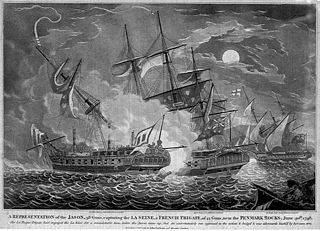Related Research Articles
Sixteen ships and two shore establishments of the Royal Navy have been named HMS Fox, after the fox.
Six ships of the Royal Navy have been named HMS Indefatigable:
Sixteen different ships of the British Royal Navy have been named HMS Greyhound, after the greyhound, a breed of dog notable for its speed.
Sixteen ships of the Royal Navy have been named HMS Mermaid after the mermaid:
Six Royal Navy ships have been called HMS Hero:
Many ships of the Royal Navy have been named HMS Garland. The name dates back to 1242, being the oldest confirmed ship name in the Royal Navy.
Nine ships and one shore establishment of the Royal Navy have been named HMS Wasp, with one other government vessel using the name:
Eleven ships of the Royal Navy have borne the name HMS Blonde:
Eleven ships of the Royal Navy have borne the name HMS Firebrand.
Six ships of the Royal Navy have borne the name HMS Arrogant, or HMS Arrogante, whilst another was planned:
Sixteen ships of the Royal Navy have borne the name HMS Alert, while another was planned:
Eleven ships of the Royal Navy have borne the name HMS Weazel or HMS Weazle, archaic spellings of weasel, while another was planned:
Thirty-nine vessels of the Royal Navy and its predecessors have borne the name Swallow, as has one dockyard craft, one naval vessel of the British East India Company, and at least two revenue cutters, all after the bird, the Swallow:

HMS Jason was a 38-gun Artois-class fifth-rate frigate of the Royal Navy. She served during the French Revolutionary Wars, but her career came to an end after just four years in service when she struck an uncharted rock off Brest and sank on 13 October 1798. She had already had an eventful career, and was involved in several engagements with French vessels.
There have been twelve ships of the Royal Navy that have been named HMS Flying Fish, after the Flying Fish.
Four ships of the Royal Navy have borne the name HMS Charwell, after the River Cherwell, a tributary of the River Thames:
Four ships of the Royal Navy have either borne the name HMS Samarang or were intended to bear the name, after the port of Samarang, the site of HMS Psyche's capture of several Dutch vessels there in 1807.
The Minerve class was a type of 40-gun frigate of the French Navy, carrying 18-pounder long guns as their main armament. Six ships of this type were built at Toulon Dockyard, and launched between 1782 and 1794. The frigates served the French Navy briefly during the French Revolutionary Wars. The Royal Navy captured all six between 1793 and 1799 and took them into service, with all but one serving in the Napoleonic Wars, and some thereafter.

HMS Arethusa was a 46-gun Leda-class fifth-rate frigate built for the Royal Navy during the 1810s. The ship was never commissioned and was converted into a lazarette in 1836. She was renamed HMS Bacchus in 1844 and was further converted into a coal hulk in 1851–52. The ship was sold for scrap in 1883.
References
- Colledge, J. J.; Warlow, Ben (2006) [1969]. Ships of the Royal Navy: The Complete Record of all Fighting Ships of the Royal Navy (Rev. ed.). London: Chatham Publishing. ISBN 978-1-86176-281-8.
- Hepper, David J. (1994) British Warship Losses in the Age of Sail, 1650-1859. (Rotherfield: Jean Boudriot). ISBN 0-948864-30-3
- Winfield, Rif (2008). British Warships in the Age of Sail 1793–1817: Design, Construction, Careers and Fates. Seaforth. ISBN 978-1-86176-246-7.